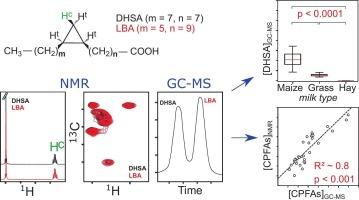Differentiating cyclopropane fatty acids to support milk authenticity through GC–MS and NMR spectroscopy
IF 8.2
1区 农林科学
Q1 CHEMISTRY, APPLIED
引用次数: 0
Abstract
Cyclopropane fatty acids (CPFAs), are emerging markers for food authentication in premium dairy products like Parmigiano Reggiano and Haymilk, where silage feeding is prohibited. This study focuses on two CPFAs—dihydrosterculic acid (DHSA) and lactobacillic acid (LBA)—in milk from cows fed diets with or without silage. Using both NMR spectroscopy and a refined GC–MS method, we quantified CPFAs and assessed their potential as dietary markers. NMR enabled rapid, non-destructive screening via cis-methylene proton signals, whereas GC–MS provided accurate quantification and separation of DHSA and LBA. DHSA levels were ∼ 3-fold higher in maize-silage-fed cows compared to non-silage-fed cows, making DHSA, or the DHSA/LBA ratio, robust markers of feeding regime. In contrast, LBA remained stable across diets and was unexpectedly detected in Haymilk, suggesting alternative metabolic origins. These results demonstrate the value of combining NMR and GC–MS for accurate CPFA quantification and provide new insights into their role in dairy authentication.

通过气相色谱-质谱和核磁共振光谱鉴别环丙烷脂肪酸以支持牛奶的真实性
环丙烷脂肪酸(CPFAs)是高级乳制品(如禁止青贮饲料的Parmigiano Reggiano和Haymilk)中食品认证的新兴标志。本研究主要研究饲喂或不饲喂青贮饲料的奶牛牛奶中的两种cpfa——双氢甾酸(DHSA)和乳酸杆菌酸(LBA)。利用核磁共振波谱和改进的气相色谱-质谱方法,我们对CPFAs进行了量化,并评估了它们作为膳食标志物的潜力。核磁共振可以通过顺式亚甲基质子信号进行快速、无损的筛选,而气相色谱-质谱可以精确地定量和分离DHSA和LBA。与非青贮奶牛相比,玉米青贮奶牛的DHSA水平高出约3倍,这使得DHSA或DHSA/LBA比率成为饲喂方式的有力标志。相比之下,LBA在饮食中保持稳定,并且意外地在Haymilk中检测到,这表明有其他代谢起源。这些结果证明了结合NMR和GC-MS对CPFA精确定量的价值,并为它们在乳制品认证中的作用提供了新的见解。
本文章由计算机程序翻译,如有差异,请以英文原文为准。
求助全文
约1分钟内获得全文
求助全文
来源期刊

Food Chemistry: X
CHEMISTRY, APPLIED-
CiteScore
4.90
自引率
6.60%
发文量
315
审稿时长
55 days
期刊介绍:
Food Chemistry: X, one of three Open Access companion journals to Food Chemistry, follows the same aims, scope, and peer-review process. It focuses on papers advancing food and biochemistry or analytical methods, prioritizing research novelty. Manuscript evaluation considers novelty, scientific rigor, field advancement, and reader interest. Excluded are studies on food molecular sciences or disease cure/prevention. Topics include food component chemistry, bioactives, processing effects, additives, contaminants, and analytical methods. The journal welcome Analytical Papers addressing food microbiology, sensory aspects, and more, emphasizing new methods with robust validation and applicability to diverse foods or regions.
 求助内容:
求助内容: 应助结果提醒方式:
应助结果提醒方式:


